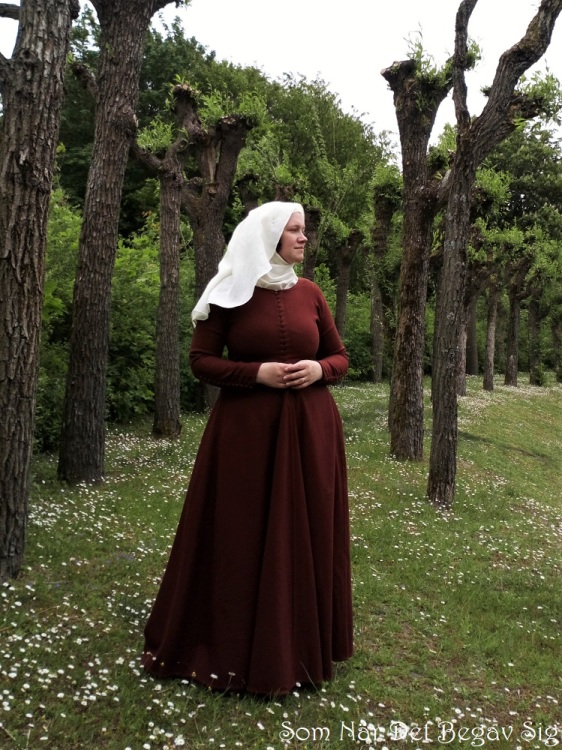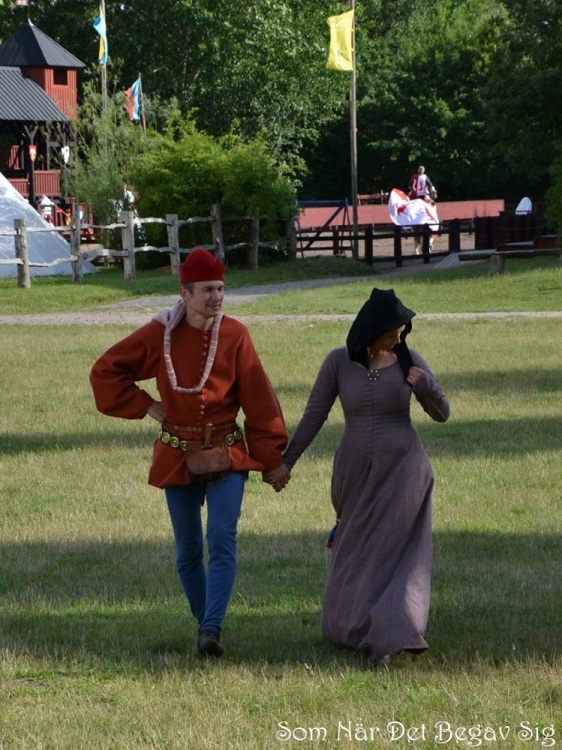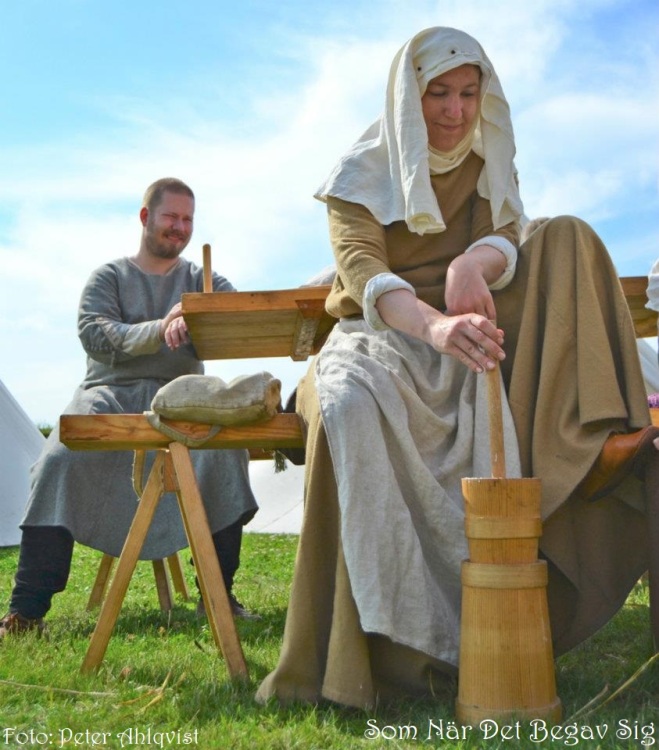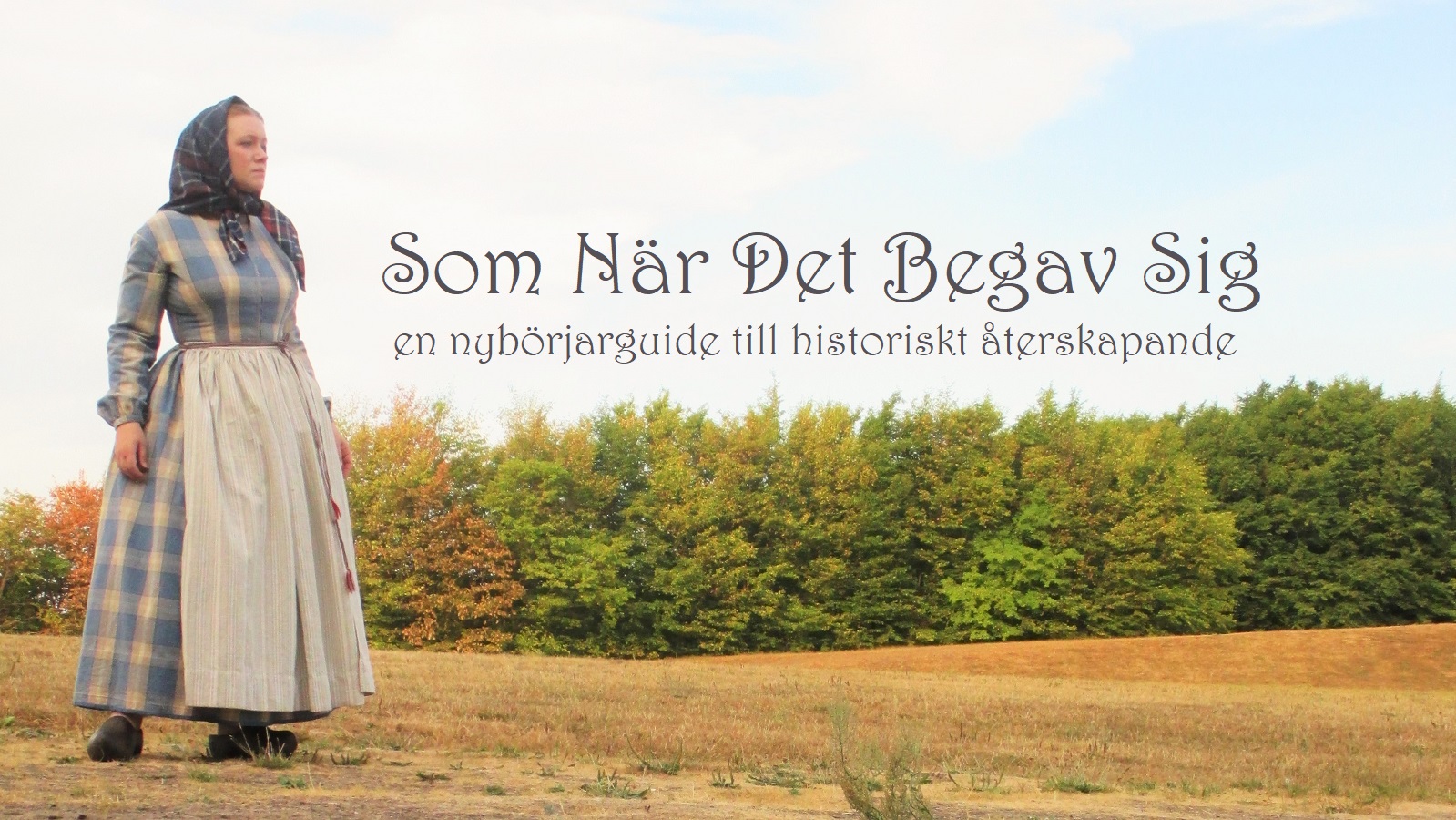This is a translation of a post that was originally written in 2013.
As I love historical clothing, living history and re-enactment in general, and do late 14th century with the other members of Albrechts Bössor (Albrecht’s Gunners), I have had ample opportunity to see people in what they consider to be medieval clothing. Some are quite close to the period they want to represent, but unfortunately many miss the target – some by a hair, some spectacularly.

I’m in no way an expert on this; I always learn new things, and that is part of the fun. I do however believe that I know more than those who haven’t even thought of the Middle Ages since history class in school but would now like proper clothes for a Medieval festival or similar. It is for you I write this beginner’s guide. My hope is that it will help you not to waste time, money and energy on clothing full of newbie mistakes. In short, it’s the guide I would have liked to have when I started out many years ago, making what I thought was a pretty decent medieval dress from a brown cotton sheet. Please note: I’m primarily writing this from a Swedish/Scandinavian point of view, which means dates or finer details may not always be applicable to the region you wish to recreate from. As a rough beginner’s guide it should be helpful though.
Here are a few things that are good to consider before you begin.
What do you mean, historical accuracy?
It’s important to understand that the Middle Ages actually existed. Your great-great-great-something-grandmother lived then. She and her husband, their families and neighbours were real people who were born, lived – ate, drank, worked, feasted, laughed and cried, rejoiced and mourned, experienced pleasure and pain – married, had children, grew old and died. They had their culture; a unique mix of national and local history, politics, superstitions and religion, just as we have ours today, and it influenced their whole lives. If you want to dress medieval you can’t just put on any old thing that’s not typically 21stcentury and believe it’ll be correct. The clothes medieval people wore were influenced by fashion, religion, class, economy, marital status, technology and available materials, to mention a few factors. There is right or wrong, since the clothing and their context existed. By dressing ourselves in the kind of clothes our ancestors wore we can come closer to our own past, in a fun way.
The tricky thing is that you have to be open to the fact that new finds and new research may give another picture of things you thought you knew, so you can never sit back and consider yourself fully learned. It’s also good to realise that no matter how much you study, you’ll never be able to recreate history perfectly. The materials you use will seldom be exactly the same as they were then. You are not used to wearing that kind of clothing: it may pinch in places you are not used to, they demand a different posture and way of moving that you have not grown into since you were a child. You have completely different opinions about politics, religion, education, proper manners and human rights than they did, and no matter how much you try, your reaction to historical events and phenomena will be influenced by your modern way of thinking.
It doesn’t mean it’s pointless to try though – quite the opposite. With research and patience, you can come pretty close, at least in looks and some behaviour. Seeing a person succeed with the material recreation is a true joy.

What’s this about source criticism?
The Internet is full of information on any number of subjects, and much of it is true and creditable. But we also know that lots of it are lies, theories, opinions without foundation in facts, and misconceptions. No matter what subject you are looking for information on you need to be critical of the sources, and that very much applies to medieval clothing as well. Who wrote the text? Are they knowledgeable in this field? What reason did they have to write it? On what did they base their information? The same goes for books, patterns and vendors. Naturally the same goes for this blog too.
To avoid beginner mistakes:
Be critical of the sources! Question! Don’t believe everything that’s being said or written. Just because a garment, piece of jewellery or a pouch is said to be medieval, that does not have to be the case. The fact is that when you Google “medieval clothing” or “medieval dress” the majority of what shows up is historically flawed – most is pure fantasy.
Letting yourself be inspired by the clothing of others is OK, but don’t copy anything: no matter how nice things are there are no guarantees that that interpretation is the correct one, even if the person wearing them is very knowledgeable. It’s a good habit to always check with the period sources (medieval pictures, texts and extant clothing) first.

What’s the intended use for your medieval clothing?
If you just want to look good, cool or pretty, without bothering about historical accuracy, your clothes can look anyway you like, but should then be called medievally inspired rather than medieval, as they are not actually historical.
If you’d like to be able to go back in time and walk through a medieval village or town without looking weir enough to turn heads, you have to be more particular in your choice of sewing patterns, materials, accessories, hairstyles etc. Look at lots of pictures from the period you’re interested in.
To avoid beginner mistakes:
If you want to look like a real medieval person, do not let yourself be inspired by medieval- or fantasy films, for their costumes are never historically accurate. Use screen costumes as inspiration for LARP, fancy dress or cosplay instead – or make them just because it’s fun. Separate history from fantasy, reality from fairytales.

What period would you like to portray?
In Sweden the Middle Ages span about 500 years, from the 1050’s to the 1520’s – the exact period may differ where you come from. Fashion changed a lot during that time. If you don’t have a specific time in mind already, look at period pictures in books and on the web, and when you find something you fancy, find out when and where it’s from. Fashion didn’t just change over time, it also differed between regions: the further between countries (geographically, culturally, politically), the greater the differences in fashion. Narrow down time and space as much as you can, ex. Sweden 1364-1415, which is the time the people in this post (all involved in Albrechts Bössor) represents. Staying within the time span of a person’s adult life, or entire lifetime if you want to push it, is pretty good as it provides natural boundaries that are realistic.
To avoid beginner mistakes:
Strive to be consistent in when your separate articles of clothing are from. Nothing screams “newbie!” like a person in garments from vastly different eras or places, except pure fantasy, of course.
What social class does the person you want to portray belong to, and how wealthy is (s)he?
Do you want to be a knight, the wife of a wealthy merchant, a skilled craftsman, a self-owning farmer, or a maidservant? The greater part of the population during the Middle Ages had limited economic possibilities, many were poor, and those reduced to begging to survive were not few. Among those who make and wear medieval clothes today these circumstances are often reversed – most want to portray prosperous ladies and men of means.
To avoid beginner mistakes:
Start simply; it’s much easier to create a nice, believable outfit belonging to a craftsman or farmer as your first kit. As you learn more, you may want to advance up the social scale – or not. Don’t try to dress like a knight or a lady if you haven’t got the knowledge, the money and the accessories for it. A pretty dress alone makes no noblewoman (and a noblewoman must be dressed after the latest fashion, with dresses made to fit her perfectly, not after a standardised pattern); hairstyle, shoes, headdress, jewellery etc also must be just right. All this takes time, studies, skills and not least money to buy material and/or finished accessories.

Are you a man or a woman?
Our thoughts of gender equality did not exist during the Middle Ages; men and women were regarded as fundamentally different, with different roles, and different ways to dress.
To avoid beginner mistakes:
Some girls and women dislike wearing dresses and think men’s clothes will do just as well. This would rarely have happened in the Middle Ages – Joan of Arc is the most famous exception, but she was just that, an exception. It’s of course different today, no one should force you to wear something you don’t want to, but women in men’s clothing should be aware that they are not historically accurate, no matter how good the clothes are in themselves.

How old are you?
Older people tended to dress in a more conservative way, a thing to keep in mind. It’s also worth noting that in a time when young teens often made their own living as apprentices or servants, there were little or no cure for illness and pain, and the work load for most were a great deal heavier than for us today, you were considered adult, middle aged and elderly at an erlier age than today, when some don’t grow up properly until they’re past thirty. Marital status is also relevant here: married women had a higher social standing than single women, so it was often emphasised by the clothing.
To avoid beginner mistakes:
Dress your age: if you’re not a blushing maiden, don’t dress like one, but go for a bit more dignity. If you’re married, cohabiting or of an age when you should reasonably have been married in medieval times, wearing some kind of veil or kerchief is generally a good idea.
If you’re a fourteen-year old lad, dressing as the son of a farmer, a craftman’s apprentice or possibly a squire is reasonable, while dressing as a knight (who were professional and very specialized warriors) in sword and armour, is not.

What materials were used?
Linen, hemp, wool, silk, fur and leather were all in use, but not every material would be used for all kinds of garments. Generally speaking this is the rule: linen and hemp for underwear and women’s veils, wool (and possibly silk) for everything else. Naturally, all kinds of modern, man made materials (like fleece, polyester, acetate, nylon, viscose/rayon, stretchy “crushed velvet” – all 20thcentury inventions that very rarely look like anything other than what they are) did not exist during the Middle Ages, and shouldn’t be used for such today. Depending on where you (or the person you wish to portray) live, cotton may also be unsuitable as it was unusual and expensive in lots of places.
Many are under the impression that wool clothes are warm and itchy, but that is almost entirely a matter of quality of the wool. Often, wool is associated with thick winter clothing, but there are wool fabrics so thin and fine they are sheer, or soft enough it can be worn comfortably against the skin. Wool also isolate against warmth as well as cold, will keep you warm even if it gets wet, and don’t catch fire easily (and when it does, it burns slowly), and often require no other cleaning than being aired outside on a damp day, possibly with brushing muddy hems. It’s a good idea to buy 100% wool, as man made fibres counteracts the natural properties of the wool: man-made fibres will make the clothes warmer and sweatier as they don’t breathe, and if you’re unlucky it can melt onto the skin if you get too close to a fire or candle. Nowadays there are several shops round the world that sell proper wool cloth to re-enactors and living historians. You can read more about wool cloth here (still to be translated).
To avoid beginner mistakes:
- Make underwear from natural or bleached (not dyed!) linen or hemp.
- Use wool for all clothing intended to be seen (hose, cotes, hoods), it will look lots better than linen.
- Burlap weren’t used for clothing, not even by the poor, so don’t put on a jute sack with holes cut for head and arms, it looks silly.

What colours were used?
Thinking the Middle Ages were all shades of browns and greys is a misconception – even if the everyday clothes of the common people were often left undyed, most colours except neon green, shocking pink and fluorescent yellow were perfectly possible to achieve with natural dyes, and brightly coloured clothing were popular. Different nuances of blue, red, pink, yellow, green, orange, brown and white were used. The meaning we often put into certain colours today were different then – pink as associated with girls seem to be a post-WWII phenomenon, so feel free to use it.
The synthetic dyes all modern clothes are dyed with did not exist during the Middle Ages. Instead, natural dyes made from plants, minerals and certain animals were used. In the dyeing process, the same dye could be used more than once, but would lose intensity each time. You could generalise and say that wealthy people wore darker and deeper colours, and common people wore lighter shades. Of all colours, deep, sooty black (coming into fashion during the late Middle Ages) was the trickiest: dyes often faded to shimmer in brown or green, and black sheep give a dark grey rather than true black wool.
Linen were usually not dyed (though there are a few rare exceptions), but were left as it was, or bleached. One reason for this may be that most natural dyes don’t take to linen very well – they fade quickly in the sun.
To avoid beginner mistakes:
- Wear colourful clothes if you like but avoid eye-watering shades. Looking at medieval pictures to see what colour combinations were popular is a good idea.
- Cool, mysterious or evil people didn’t all dress in black (this is not poorly written fantasy), but in the colour that happened to be fashionable – during most of the Middle Ages, it wasn’t Again, look at period pictures.
- Linen should be white or unbleached. Only use dyed linen if you’ve studied it in depth and have a good understanding of when it’s suitable.
- Garments should be made all in one colour, or if you do 14th century have left side (back, front, sleeve) in one colour, and the right side in another. Gores in a contrasting fabric was not a period practice.

Did they have patterned clothes?
Yes, they did. Solid colours seem to have been the most common by far, but there are examples of woven stripes and checks both in period pictures and extant material. More complex patterns like animals and plants woven in silk also existed, but were naturally only affordable by the exceedingly wealthy. Embroidery was another option, but we know rather little about non ecclesiastical embroidered clothing as not much has survived.
To avoid beginner mistakes:
- Predominantly use solid coloured fabrics.
- Chose simple stripes and checks, avoid typical tartans.
- Avoid embroidery until you’ve studied it a lot and can make an educated guess.
- Don’t use decorative ribbons from the modern haberdashery shop, there’s nothing medieval about them.

How were clothes sewn?
A functional sewing machine were not invented until the mid-19th century, a good 300 years after the end of the Middle Ages. Before that everything – clothes, shoes, bags and purses, quilts, pillows, towels, etc. – were hand sewn using waxed linen thread, or thread of silk or wool. Those with knowledge of hand sewing will usually see the difference between hand sewn and machine sewn seams at a glance. The stitches and seams used before the invention of the sewing machine were adapted to hand sewing, and different stitches were used for different things, depending on how strong you wanted the seam, how quick it was to sew, or what gave the desired effect.
To avoid beginner mistakes:
Consider what you want to get out of making your medieval clothing: do you want them finished as soon as possible, or do you want to learn the different medieval techniques? Those with a slightly higher ambition for their medieval clothes choose to sew only the inside seams by machine, and hand sews everything that will show. Chose to sew with an undyed linen thread, or thread of silk or wool – cotton (or polyester) thread matching the clothes is a modern thing. Those dedicated to living history (like everyone in these pictures) usually sew everything by hand, using period stitches, even if it will never show.

In what order would you get dressed?
The idea of armour and weapons can be intriguing, and the thought of a billowing cloak tantalising, but nether are among the first or most vital things to get when starting out. They’re actually pretty far down on the list. Underwear, something to cover feet and legs, your torso and often head is far more important.
To avoid beginner mistakes:
Start with the most important pieces of clothing first, not necessarily what you think is most fun. Think of what you actually need. Would you buy a nice jacket if you didn’t own underwear or socks? Or get a party dress if you didn’t have any shoes or jumpers for everyday? It’s equally important to kit out your medieval self in the right order. Also consider what kinds of events you’ll mostly be attending and make clothes that will be suitable for them.
References:
Andersson, E. (2006). Kläderna och människan i medeltidens Sverige och Norge.Doktorsavhandling, Götebrgs Universitet, Historiska Institutionen.
Crowfoot, E. Pritchard, F. & Stainland, K. (2001). Textiles and Clothing c.1150-c.1450. Bury St Edmunds: Museum of London.
Harrison, D. (2002). Jarlens Sekel. Stockholm: Ordfront Förlag.
Nockert, M. (1985). Bockstensmannen och hans dräkt. Falkenberg: Stiftelsen Hallands Länsmuseer, Halmstad och Varberg.
Piponnier, F & Mane, P. (1997). Dress in the Middle Ages. New Haven and London: Yale University Press.
Østergård, E. (2004). Woven Into the Earth. Denmark: Aarhus University Press.
If you appreciate this post and would like more in the same style, support me on Patreon – for the equivalent of a dollar a month you’ll get news of what I’m working on, and the opportunity to wish for tutorials and blog posts.
